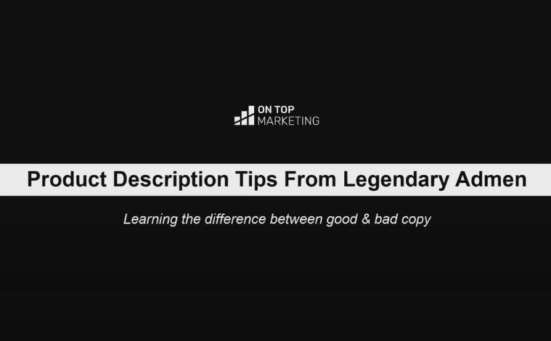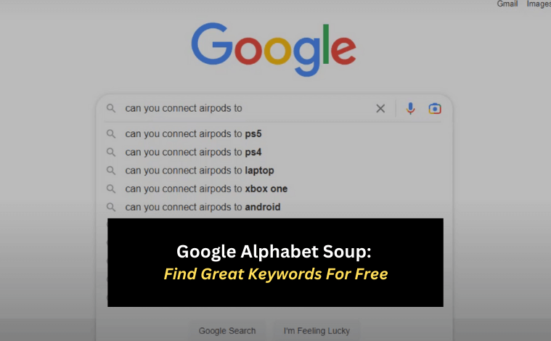
Over the past couple of years, me and my team have been very busy building ridiculously high-traffic websites. One of the main strategies we use to grow our traffic is blogging.
In this article, I will outline some of the key things we do to make a great blog post.
If you apply ALL of the tips I share in this video to your blogs, you can expect to see similar results to what me and my team achieve on our projects.
For this article, I am not going to talk about how to do research or how to write blog posts. Instead, we are going to focus on two important things, and that is how we structure blog posts and how to ultimately publish the blog posts to bring in more traffic to our sites.
9 Tips To Get More Traffic To Your Blog Posts
To make it easier to show you how things are done when they are done right, let me use the blog post I recently published, 26 WordPress Blog SEO Tips That I Wish I Knew Earlier, as our example throughout this article.
Make sure to read through each one to get the best results you can for every blog post you publish.
1. Break Your Content up with Heading Tags
When structuring your article, ensure that you make use of Heading Tags.
The primary function of Heading Tags is to separate sections of your blog.
A Heading 2, for example, separates the blog into parts, while a Heading 3 tag breaks up these sub-sections even more.
A Heading 2 <h2> looks like this:

And a Heading 3 looks like this:
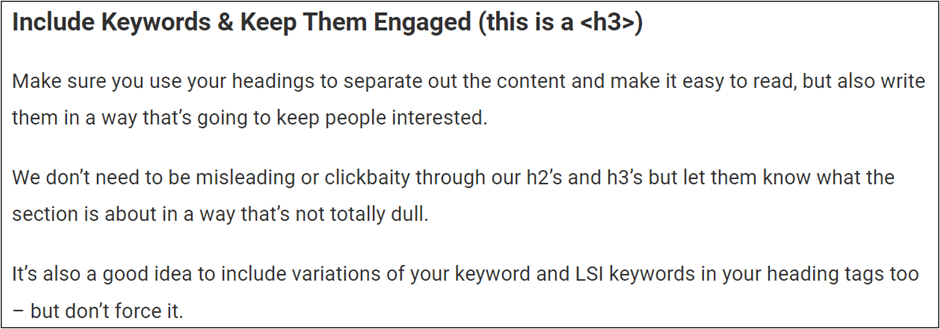
Notice how the heading 3 tags have a smaller font size to the heading 2 tags? This is to show the reader that this is a sub section, and not a new section of the article.
Why should you aim to use Headings for your blog posts?
Headings make your content digestible for readers.
By breaking up content with the appropriate heading tags, it will ultimately help the reader as they move through your article.
As well as making it easier on the eyes, using Heading Tags also allows Google to have a better idea of what your content is all about.
Helping Google have a better grasp of what your content is about can do wonders for SEO. So make sure you break up your content with descriptive H2s, H3s (and even H4s where necessary)!
2. Focus on Creating The Best Articles Online
It may be tempting to make use of 7,000 words of AI drivel on your site. After all, Google ultimately bases its rankings on how long the article is, right?
Wrong. Although article length is certainly a significant factor when trying to rank your content, it is best to remember that the quality of your content is more important than its quantity.
A 2,000 word article can definitely rank higher than the one with 7,000 words – as long as it gives the readers exactly what they came for.
Mistakes to avoid when structuring your content
Writing overly long paragraphs
Reading a long paragraph with no sub-sections may confuse the readers. It can also make tire their eyes.
And because they have a bad experience, the visitor will immediately find another article that is better structured and much more readable.
Instead of writing long paragraphs, try breaking your content down into one, two, or three sentences per section. And make sure you’re constantly changing up your sentence structure.
This is where Heading Tags can help you. By using H2s, H3s, and even H4s, you can create a better user experience and allow information to get easily absorbed without tiring (and boring) your readers.
Fully relying on AI to write your content
Don’t get me wrong: AI is an amazing tool that can really help in a lot of situations.
However, it is not good to fully rely on it to write and structure your content. This is because it writes in a way that is unnatural, and often repeats itself over and over.
It also uses the same sentence structure over and over again – giving you paragraphs with similar word counts.
This is why I always tell my writers to lead the AI, don’t let it lead you
Keyword Stuffing
An old practice that many writers used to do (and are still doing) to hopefully get higher rankings is stuffing their content with keywords. Unfortunately, doing so just makes their content difficult for readers to understand.
Instead of bombarding your content with keywords, focus on writing with the intention of the other person understanding what you’re trying to explain.
Write your article in-depth and cover the topic fully. By explaining your content in detail, there will be no need to stuff keywords all over the place, as it will all be naturally placed in your content.
Copying somebody’s content word for word
Never, ever, copy content from another site word for word.
Why? Because it is a very clear indication of a low-quality article.
When Google sees duplicate content, it basically says: “We already saw that content from another site, indexed it, and you’re just obviously copying it from them.” The result? All your efforts wasted and a lower-ranking page.
See, there’s nothing wrong with having a look at someone else’s website. You can read what they’re saying. Learn from what they said. Then, have your own take by rewording some of the content, making the content yours, then publishing it on your page.
I mean, that’s how the majority of the internet works. Just don’t copy and paste the work of another site and claim it as your own.
Using overly complicated words
When you want to reach as many readers as possible, using complex words nobody uses in day-to-day conversation is not the way to go.
Who wants to read something that doesn’t make sense to them?
Often times when people hear/read a word they don’t understand their mind switches off to the rest of what you’re saying – and that’s never what we want.
Always use simple words. You are trying to help the reader, not to sound like you have an IQ on par with Einstein’s. If you want a higher-ranking page that helps your reader, stay on topic, be clear and precise, and explain your content in more detail. That way, readers will not feel the need to find another website to visit.
Here’s some examples:
| Word to avoid | Word to use instead |
|---|---|
| Lengthy | Long |
| Calculate | Work out |
| Obtain | Get |
| Prior to | Before |
| Post | After |
| Prevent | Stop |
| Construct | Make |
| Elaborate | Explain |
| Utalise | Use |
| Facilitate | Help |
| Mitigate | Reduce |
| Circumvent | Avoid |
I always tell my writers this:
Write as if their life depended on the other person understanding what they’re saying. Because if your life depended on it: You wouldn’t go off-topic. You wouldn’t care about sounding smart. And you’d make sure you was as clear and precise as possible – going into every little detail that might help them understand and checking the accuracy of everything you say.
Dan Jones (On Top Marketing)
3. Give The Answer Straight Away, Then Expand Out
Newer writers tend to give the answers to their articles at the very end of their page. This is usually an effort to make the readers stay as long as possible.
Unfortunately, this beating around the bush is NOT effective when it comes to ranking articles. Making visitors scroll through looking for answers will just make them leave your website.
What to do instead? Give the reader the answer right away. Then, expand out with more details, and then go into the next logical question they’re likely to ask.
Using the article below is not an effective example to this, as I was talking about 26 tips for WordPress Blog SEO:

When it comes to blog posts with loads of answers or in a listicle format, giving the answers straight away may not be possible.
Let’s take a look at another topic that is meant to answer a direct question. In this case, let’s see the top-ranking articles when we search for “What is SEO?” in Google. The number 1 ranking site displayed as of this moment comes from Search Engine Land[1].
See how they answered the question in the first paragraph of the article?
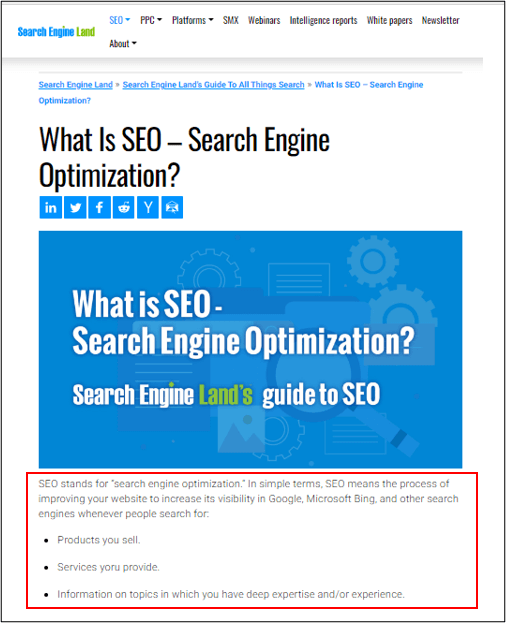
Even with a slight typo error, the site managed to beat competitors and maintained a high ranking by giving the answer to readers straight away.
Next, they gave an overview of what else you’ll learn from their article:
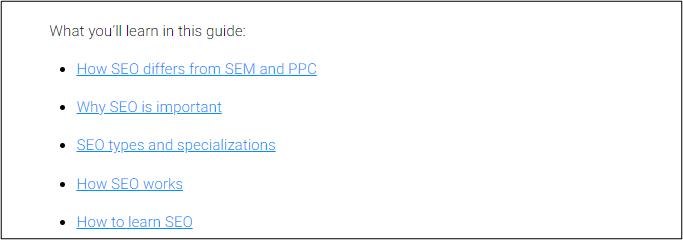
And then they go on to explain in more detail another question related to their topic:
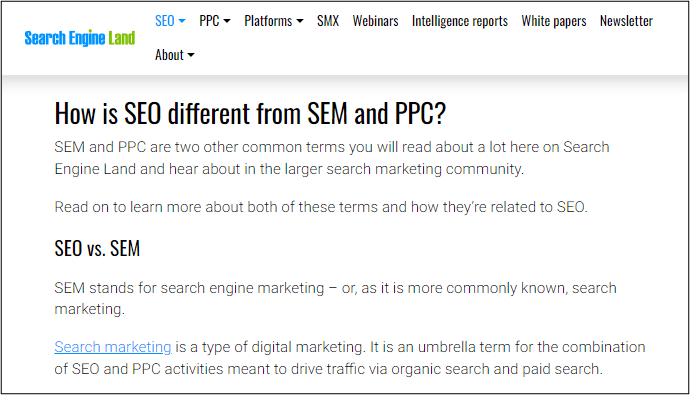
Notice how they answered a question that is highly related to their topic? Now, if their readers are confused about whether SEO is similar to SEM or PPC, they don’t need to do another Google search for it.
Why? Because the content is structured in a way that answers the readers’ questions effectively. No time wasted.
4. Breaking Content Up With Relevant Images
You may already have a highly informative article waiting to be published. Detailed, with clear instructions and explanations.
However, if you end up with a great big wall of text on your page, it will definitely bore your readers and increase your bounce rate.
Break your long paragraphs up using images relevant to your content.
This also illustrates the point you are trying to make, plus, images make your content more interesting!
Tips When Adding Images to your Blog
Optimize your images
Using images with a huge file size is not a good idea, as it can affect the load time of your page.
To avoid using images that are bigger than what they need to be, using a compression tool such as TinyPNG will be best, as it can reduce the file size of your photo without affecting its quality too much.

Just drop your photo, wait for it to be compressed, and download.
Name images correctly
Did you know that putting a description of the images you use also helps in ranking your page?
Just by using a proper file name that describes the image and also using the same name as the Alt Text, you can get some good traffic.
For example, in this image:
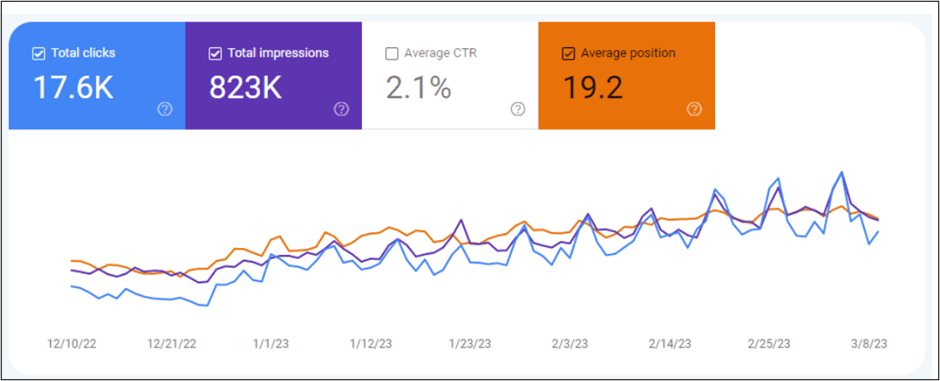
Its file name and Alt Text is “search console after putting Ezoic ads on site”. The Alternative Text on this image is exactly what is being shown in the image.
Contrary to what other people believe, reusing images on your other pages is okay! As long as it is relevant to the topic.
5. Style The Blog With CSS Classes
Another great feature you can use to make your blog post more appealing and engaging is Custom CSS Classes.
To make pieces of content stand out, me and my team make use of various elements, such as:
- Ticks
- Crosses
- Arrows
And also:
Blue boxes
Green boxes
Red boxes
Take a look at this very article, for example. You can definitely see that pieces of information or data are more digestible and easy to understand with the use of CSS classes.
This is easy to do and makes pages more professional-looking and high quality.
SEE ALSO: Use CSS Classes To Make The Page Look Interesting
6. Internal Links That Help Or Interest The Reader
Adding internal links to your content can help your readers, as long as it is relevant to what you are currently talking about.
The best way I found to add an internal link is by using the SEE ALSO Method, like the one I used in Tip Number 5. Notice how you can click through the linked text, “Use CSS Classes To Make The Page Look Interesting” to give more information to the reader?
Since the content is relevant to what I was talking about, giving the readers an option to learn more about how to use CSS Classes may be something they find helpful. Also, doing so will add to the traffic on the page, which is a positive thing for our rankings of the page we’re linking to.
7. Add Relevant FAQs
You may notice that in every blog post that me and my team write, around 99% have a Frequently Asked Question (FAQs) section in the bottom.
Why do we do this? Because it can make our SERP listing bigger. It also shows Google that our article is super relevant as it answers most of the questions being asked about a particular topic by many people.
In our blogs, we usually add around 5 questions that are related to what we are talking about.
Check out the FAQs section in our article, 26 WordPress Blog SEO Tips That I Wish I Knew Earlier below:
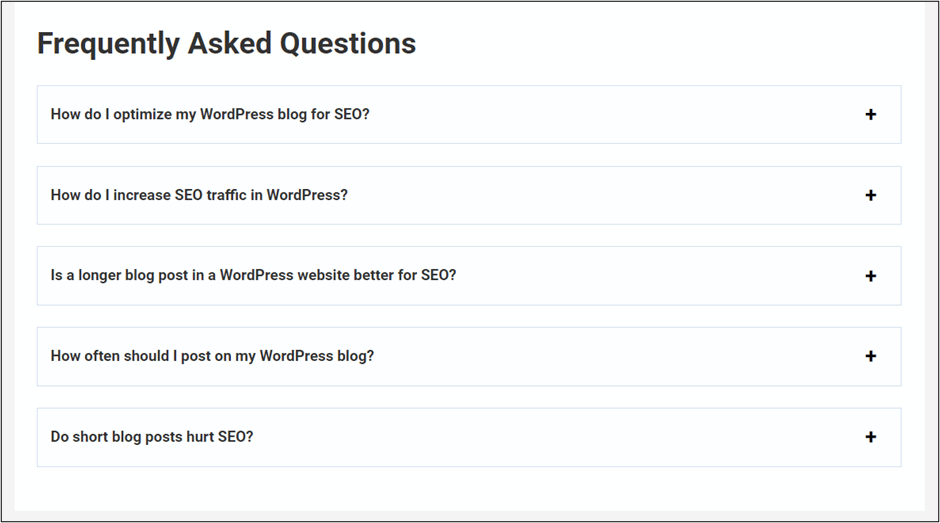
Where can you find relevant questions for your blog post?
People Also Ask in Google
The best way for you to find questions for your blog post is by looking on Google.
Copy and paste the title of your article, then scroll down to the People also ask section shown on Google.
When I search for “wordpress blog seo tips”, this appears in the People also ask:

Choose questions that are relevant to your content.
People also ask only initially displays 4 questions. To have more options, simply click on the arrow pointing down of one question, click the arrow pointing up to close the accordion, and then more questions will be displayed that are relevant to that question.
Answer Socrates
Answer Socrates[2] is a site you can enter your topic in, and it generates a list of questions people are asking all over the internet.
Since it is a free tool with lots of users, you may find the loading time to be quite slow.
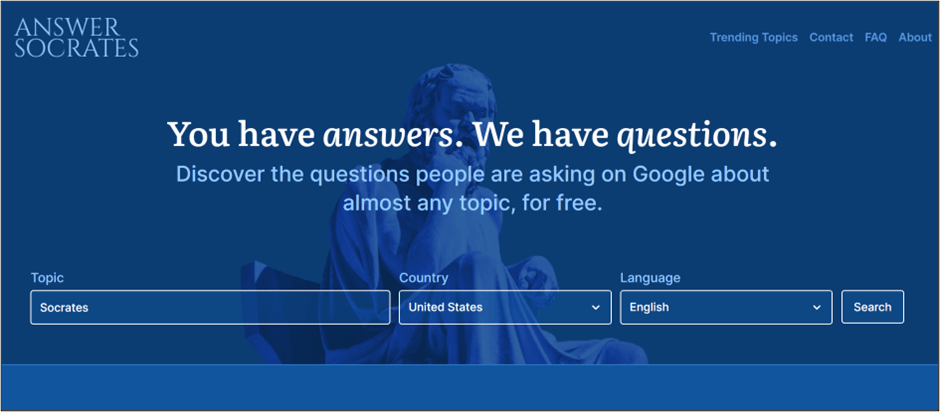
AnswerThePublic
Similar to what Answer Socrates does, AnswerThePublic[3] is a site that also gives out a list of questions people ask about a particular topic on the internet.
If you’re using AnswerThePublic for free, there is a limit to the topics you can search for, which is only one to two topics per day.
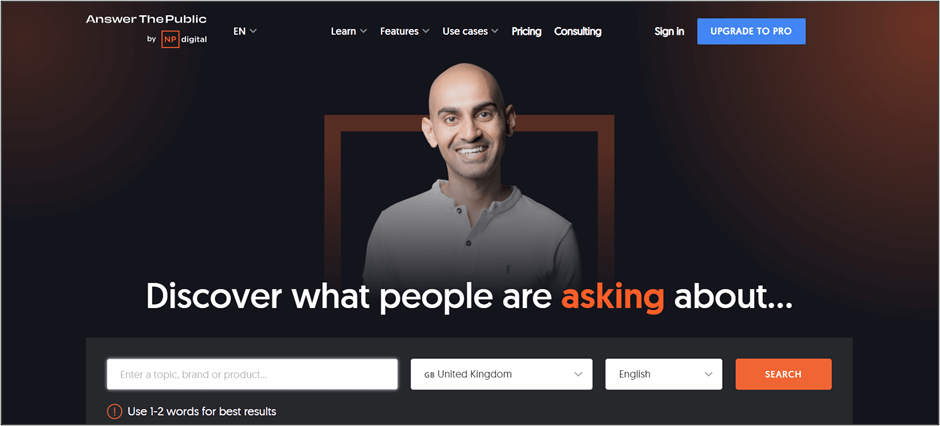
8. Create High Quality Featured Images
The Featured Image on your blog post is more than an attractive image for your content. Even by the name itself, a “Featured” Image is the first thing that your readers often see first.
Put your highest efforts into creating your featured images. If possible, make it display the end result of your article.
Show what would happen if they followed your tips and more, depending on what your content is. Since people are most interested in what they can get from reading your article, make the image as relevant as you can.
Tips for Creating your Featured Images
- Put text on your featured image
Add the text you are targeting on the image. It’s best to add the text that is similar to your Title Tag. - Avoid including numbers (when you have them on your title tag)
Usually for listicles, you may have a number included on your title that shows, for example, how many tips you will give to your readers.
When making your featured image, however, it is best not to include them. In a situation where you update your article, add more tips or stuff on your list, then you wouldn’t need to edit your image again. - Optimise your image
Make sure to compress the file size of your featured image to avoid adding unnecessary load time to your site.
See the featured image below:
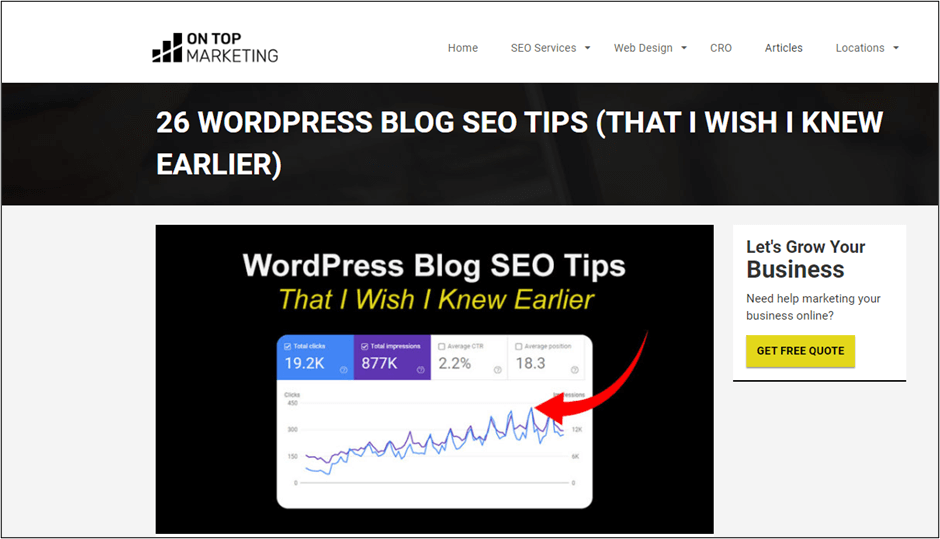
Why is it a good featured image?
- The image used is relevant
It shows an increase in traffic of a particular site, since the topic focuses on tips for doing SEO. - There is text on the image
The text is also similar to the Title Tag in the article. - It does not include the number on the Title
Although there is the number 26 on the Title of the content, it was not included in the image to avoid unnecessary revisions later on. - It is optimised
The size of the image has been compressed, without affecting its quality.
What if you have no relevant images related to your topic? Try choosing an image that may show a part of the process, or something that can somehow be related to your topic.
For example, if the article is about “How to become the world’s greatest piano player”, you can definitely add an image of someone just playing the piano, since showing the end result may be quite challenging to find a photo for.
Featured images need to be planned effectively because:
- When your featured image gets pulled by the SERPs on mobiles and desktops, it will have a huge impact on the click-through rate of your article.
- It also affects your internal traffic, as it helps with the click-through rate when your featured image comes up on the homepage, blog index, and related articles on your website.
9. Make Sure The Blog is Better Than Other Blogs Google is Ranking
Now that we are almost done, there is one thing we need to do before publishing: see if our content is better than the top ones currently ranking in Google.
See, winning in SEO is basically making sure that our article is the BEST article among all ones we can find in Google. And the way we do this is by checking if our content is more complete and more comprehensive content than anyone else’s.
How to check if your article is better than the others:
- Go back to Google, search for your main keyword, and click the top three articles on the list.
- Go through all the points they made. Were you able to cover all the points and important information they have in their content? Are your answers more concise and in-depth than what they did?
- Add in the important pieces of information that are not yet in your article. If the top-ranking sites are talking about it, chances are Google finds that information important. Hence, it will be best for us to cover those topics as well.
When doing this important step, you are learning from everybody, combining all the information, and mixing it with your own experience. As a result, you are creating an article that Google loves, because you made a piece of content that answers exactly what the reader wants and needs.
Do You Have Any Tips To Share?
Ranking high in Google does not need to be overly complicated. Provided that you follow the tips above, improving your SEO rankings is certainly within your reach.
Have more tips and experiences you can share? Let us see how YOU were able to improve your ranking in the comments.
Frequently Asked Questions
SEO in blogging stands for Search Engine Optimization. It is essentially the process of getting traffic with the use of various methods to rank in search engines.
The best primary ways to structure an article for SEO are to have proper headings, use keywords, optimize your images, build links, and most importantly, use quality content.
Although there are many blogging platforms, many professionals use WordPress because of its reliability and ease of use. Using plugins such as Yoast SEO can also be of great help in optimizing your blog’s content.
It is important to be consistent in posting your blogs for SEO. Many top-ranking sites aim to publish 1 – 2 blogs per week.
SEO is truly important for a business blog as it can bring in more visitors to your page. As a result, you will have a higher reach and a better chance of turning these visitors into customers.


